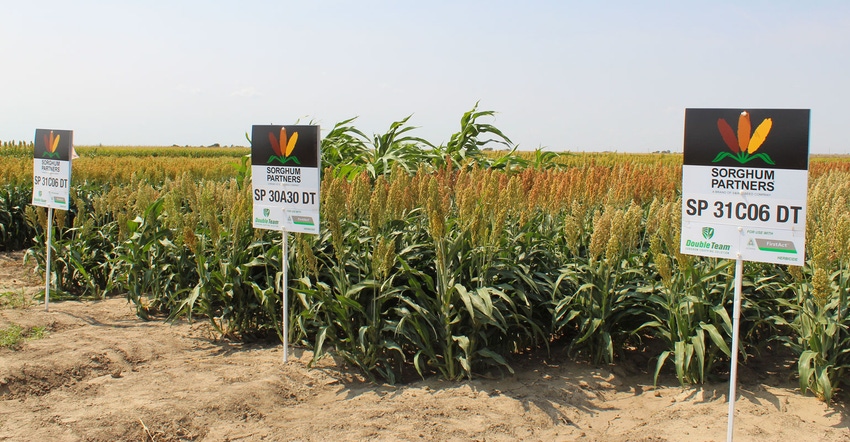September 7, 2021

Almost 20 years ago, over-the-top grassy weed control in sorghum was a farmer wish. Today, Sorghum Partners, a brand of S&W Seed Co., is rolling out its Double Team Sorghum Cropping Solution, making that wish a reality.
Scott Staggenborg, Sorghum Partners sorghum product marketing director, recalls surveying sorghum growers about their needs back in the early 2000s.
“What growers said they needed, and what we should be working on as researchers to improve sorghum growers’ lives, came back to yield and weed control,” Staggenborg says. Specifically, over-the-top grassy weed control. That was the one thing that had farmers turning to raising corn over raising sorghum, especially on their dryland or limited irrigated acres.
So, researchers started searching through wild relatives of sorghum for genetic mutations that could be added to commercial hybrid sorghum varieties.
Today, following years of research and trials, Double Team Sorghum is now available for commercial sales.
The DT trait
Double Team Sorghum includes the DT Sorghum Trait that has been included in selected hybrids from the company, and the FirstAct herbicide from Adama.
Staggenborg says the trait, which confers tolerance of the FirstAct herbicide to the DT Sorghum plants, is non-GMO, because the company started from lab tissue cultures from proprietary genetics of an elite breeding line in 2015 that were further developed through conventional breeding procedures. In 2019, they were ready to go with larger commercial testing in farmer fields.
“The hybrids performed really well, I think, because we started with elite genetics,” Staggenborg says. “We didn’t see any yield drag.” And it was found that some of the DT sorghums mature a few days earlier than the other hybrids in the Sorghum Partners lineup.
Grassy weed control
It is important growers understand that Double Team sorghums are different from other sorghum hybrid cropping systems on the market. The DT trait requires the use of FirstAct herbicide, which contains a Group 1 Accase inhibitor. Farmers may know FirstAct as quizalafop, or the brand name Assure II, which has been used for quite some time in soybeans, cotton, and Enlist corn hybrids. That means that there are very specific use and stewardship steps farmers need to follow.
Hank Mager is the product development manager at Adama, and he stresses that stewardship of this trait and its longevity depends on farmers following the guidelines they have in place.
First, Mager says the farmer should make every effort to start with a clean field, like they would with any other sorghum hybrid.
“We want to go in with a field that’s been clean-tilled or has been burned down, so that we’re not starting with a weed problem before we get our crop going,” Mager says. In the Double Team system, farmers are required to apply at least a half-rate of grass control preemergent herbicide with either dimethenamid-P, or acetochlor, active ingredients.
It’s also good, Mager says, if, after the crop gets started, farmers go back in and control their broadleaf weeds early in the season. Using an herbicide like atrazine, saflufenacil or mesotrione in a tankmix with that grass-control product helps.
That preemergent herbicide pass is meant to keep the weeds back until the Double Team sorghum reaches its 12-inch height restriction. At that point, the sorghum is at the eight-leaf stage or later, and then the first application of FirstAct is approved over the top of the sorghum.
“You can do up to two [applications of FirstAct] a year if you need to,” Mager says. That way, if there’s a second flush of grassy weeds, farmers can go back in and make a second application later in the season, up to 45 days before harvest.
Stewardship
FirstAct is labeled to control a large variety of grassy weeds, including crabgrass, bermudagrass, wild oats, downy brome, jointed oatgrass, volunteer barley, volunteer oats, volunteer rye, wild proso millet, Italian ryegrass and more.
However, sorghum is also closely related to johnsongrass and shattercane, and pollen can transfer from sorghum to those species, Mager says. If that happens, those grasses could become quizalafop-resistant, which is the last thing we want, he adds.
“So, we have very specific guidelines around rotating out of the system,” Mager says. “You can follow up with sorghum the following year, but you’d have to use one of the other competitive systems, or a conventional sorghum. Or, obviously, you can rotate to corn or wheat. But you can’t do Double Team sorghum back to back.” It also wouldn’t be advisable to rotate to an Enlist corn, soybean or cotton variety as well.
Mager says farmers must manage their johnsongrass and shattercane in field edges and ditches, so that those grassy weeds aren’t pollinating at the same time as the sorghum. That can be accomplished by mowing ditches when sorghum is pollinating, thereby stopping the chance that genes can be transferred from the sorghum to the ditch grasses.
Not commodity grain
In 2021, grain from the Double Team system must be kept out of the commodity grain channel, according to Sorghum Partners. Staggenborg says the company still awaits Canadian approval for the DT trait, which should come by the end of 2021. The trait, however, is approved for the United States, and Double Team grain sorghum can go into animal feeding, ethanol production, pet food and other industrial uses.
The five DT hybrids currently available are cream and bronze grain sorghums with high yield potential. One offers good drought tolerance, and another has moderate sugarcane aphid tolerance. The second generation of DT hybrids will probably include a forage sorghum and will look to offer sugarcane aphid tolerance, and likely some anthracnose resistance, too.
To learn more about the Double Team Sorghum Cropping Solution, growers should visit sorghumpartners.com/double-team, or contact a Sorghum Partners representative, Staggenborg says.
You May Also Like




